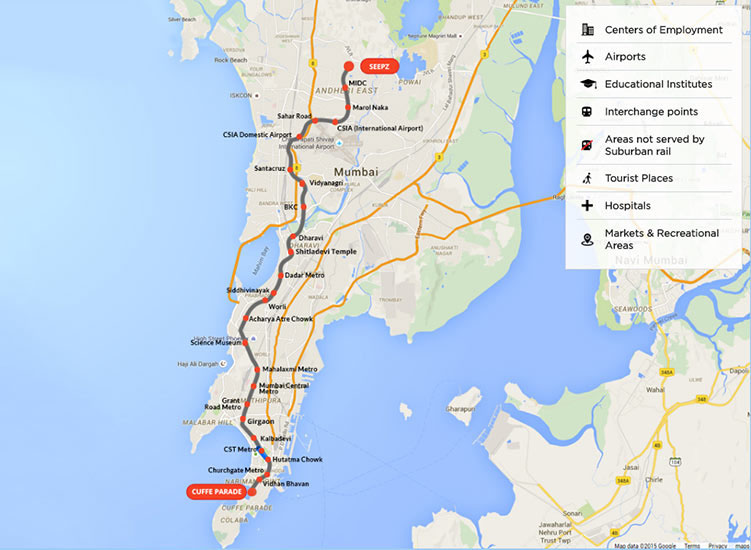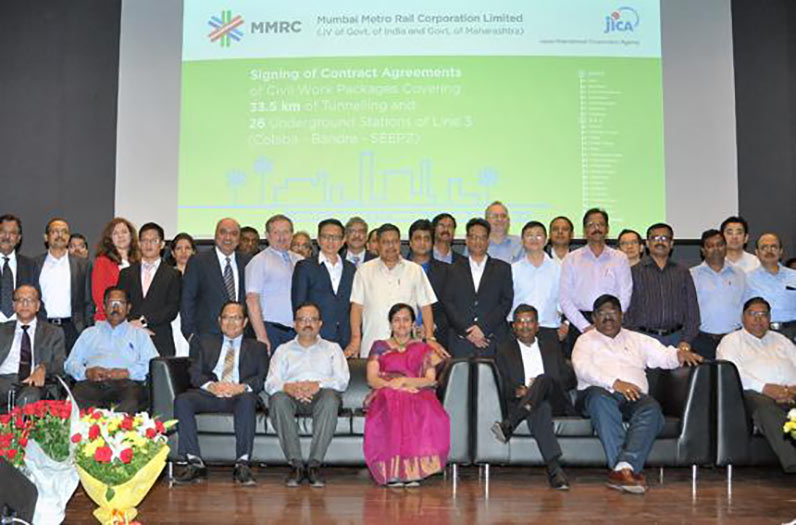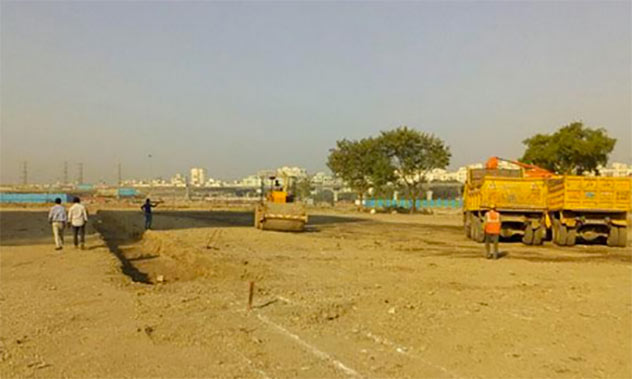Works start on Mumbai Metro Line 3 15 Dec 2016
Line 3 for the Mumbai Metro system has been long discussed and anticipated but aspirations are high that the long awaited all underground addition to mass transportation services for the city will be realized and opened according to programme in 2020.
The 33.5km long largely underground corridor runs north-south to connect the Colaba-Bandra-SEEPZ districts and has 26 underground stations and one station at grade (Fig 1).
Construction of the line is divided into eight civil contracts of which the seven tunnel-and-station packages were tendered during 2015 and awarded in 2016 with the civil works for the line’s depot yet to be awarded.
The contractors on each package have started work on each of the contract sites for the open-cut station boxes and have confirmed procurement of the 17 TBMs needed to excavate the twin tube running tunnels (Table 1).
The project is being developed by the Mumbai Metro Rail Corporation Ltd (MMRC) which is a joint venture delivery entity of the central Government of India and the State Government of Maharashtra State. Where PPP vehicles have been used for procurement of previous public transit systems with painful consequences, Line 3 is a traditional EPC engineering, procurement, construction or design-bid-build operation, much on the same lines as the Delhi Metro procurement model which has proven successful and manageable.
Line 3 has an estimated cost INR23,136 crore or about $US3.4 billion and is being financed by a loan of INR13,235 crore or $US1.9 billion from the Japan International Co-operation Agency (JICA) which accounts for 57.2% of the total cost. The funding balance is made available by the Government of India and the State Government of Maharashtra/MMRDA, in the form of equity and subordinate debt, and by a 3.4% contribution from the Mumbai International Airport Pvt Ltd corporation (MIAL).
In May 2016 MMRC pointed the AECOM Asia led consortium under project contract package 18, with partner consultants Padeco, (Japan); LBG Inc (USA) and Egis Rail (France) as General Consultants for the Line-3 project and on the Quality and Cost basis in concurrence with JICA guidelines. As General Consultants the team will assist MMRC in design, supervision, quality control, safety and contract management of the project and broadly:
- Assisted in evaluation of bids for civil works
- Review and proof-checking of detailed designs
- Prepare tender design and documents for procurement of track work, rolling stock, system components
- Supervise construction
- Supervise works and ensure safety, quality and environmental aspects
- Manage the commissioning of all system components
- Test and commission the entire system
- Prepare/finalize operation and maintenance manuals
The timeline for development of mass public transit for Mumbai started with a metro concept proposal in 1969. This was review in 1991, resulted in a feasibility by MMPG in 1997, became a Mumbai Metro Master Plan in 2003 that comprised a network of 146km on nine corridors and built in three phases for three lines.
In 2006, Line 1 was awarded as a public-private-partnership (PPP) as a mainly elevated alignment and in 2008, Line 2, also mainly as an elevated project, was awarded also on the PPP model. In 2009 preparatory procurement work for Line 3 was also based on a PPP model but major problems and delays on the Line 1 and 2 PPP projects, mainly due to land acquisition, right-of-way permissions and utility and traffic diversion issues and delays as the PPP partners argued among themselves who exactly was responsible for securing these project requirements and caused serious delays and court case actions, some that are ongoing still today.
In 2011, Line 3 was reinstated on an EPC procurement model and with substantial funding offered from the JICA. With appointment of the General Consultants in May 2016, award of contracts in August 2016 and ground breaking ceremonies in October 2016, work on all tunnel and station packages is underway and 2020 remains the ambitious start date of services on the line.
Ahead of that procurement of the depot civil contract is awaited along with package awards for track works, traction, signalling, station security systems, automatic fare collections, tunnel ventilation and environment air conditioning, lifts and escalators and rolling stock procurement are programmed for the first and second quarters of 2017.
Resolution or at least assistance in easing the chronic traffic congestion in the city and provide a service for the many thousands of commuters in the city is hanging of long awaiting construction of the central Line 3 of the metro. Its underground alignment will also assist the city during construction and provide the long-term lifecycle and maintenance cost advantages of the underground infrastructure option.
References
- Lucknow begins metro TBM tunnelling – TunnelTalk, November 2016
- EPBM breakthrough in Delhi – TunnelTalk, September 2015
- Final end to tough Bangalore TBM drives – TunnelTalk, March 2011
- Contractor walkout sparks Chennai Metro retender – TunnelTalk, January 2016
- Triumph out of tough going on Delhi Metro – TunnelTalk, October 2004
|
|
|
|
|
Add your comment
- Thank you for taking the time to share your thoughts and comments. You share in the wider tunnelling community, so please keep your comments smart and civil. Don't attack other readers personally, and keep your language professional.






